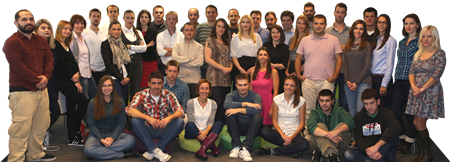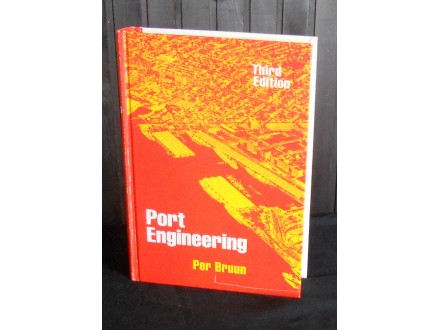PORT ENGINEERING-Per Bruun (Projektovanje i izgr. luka)
| Cena: |
| Želi ovaj predmet: | 4 |
| Stanje: | Polovan bez oštećenja |
| Garancija: | Ne |
| Isporuka: | Post Express Lično preuzimanje |
| Plaćanje: | Tekući račun (pre slanja) Lično |
| Grad: |
Novi Beograd, Beograd-Novi Beograd |
ISBN: 0-87201-739-7
Godina izdanja: 1981
Jezik: Engleski
Oblast: Građevinarstvo
Autor: Strani
Pun naslov: PORT ENGINEERING
Third Edition
Autor: PER BRUUN
with contributions by:
E.G. Frankel
Massachusetts Institute of Technology
O.G. Houmb
Norwegian Institute of Technology
G. Moe
Norwegian Institute of Technology
E. Bratteland
Norwegian Institute of Technology
• Izdavač: Gulf Publishing Company,
o Book Division, Houston,
o London Paris ,Tokyo
• Godina izdanja: 1981., Third Edition
• Jezik: Engleski
• Format: 7’5” x 10’2” (19cm x 26cm )
• Oprema:Tvvrdi povez, plastificiran, bogato ilustrovan crtežima i fotografijama.
• Broj strana:787
• Stanje: Knjiga je malo korišćena, u odličnom stanju, skoro kao nova.Na prednjem podlisku na 2 mesta ispisan broj 2216 i spolja na hrbatu (jedva vidljivo) .
•
•*¨*✿✿¸¸.•*¨*✿✿¬¸.•*•*¨*✿✿¸¸.•*¨*✿✿¬¸.•
Knjiga Port Engineering je u sadasnjem trenutku najkompletniji izvor informacija za projektovanje i izvodjenje Luka.
•*¨*✿✿¸¸.•*¨*✿✿¬¸.•*•*¨*✿✿¸¸.•*¨*✿✿¬¸.•
Review
This third edition of Port engineering reaffirms the book`s stature as the most comprehensive, up-to-date source of poor planning, design, and engineering information available. New material on the latest trends in shipping technology, navigation techniques and transportation procedures, or development, and economics makes Port engineering the essential state-of-the-art reference in the specialized yet vital field.
The book`s broad coverage is now greatly expanded with more than 120 new figures, tables, graphs, etc.,: new information on portal layout and site selection: optimal dimensions of maritime fairways and shallow seas and sea straits: and the latest advances in Breakwater, Mooring, and fendering design. This third edition also describes the most recent developments in dredging technology, including the environmental aspects of disposal of dredged material, Littoral drift and sedimentation problems are examined in detail to help engineers plan and maintain a port by dredging or bypassing. In addition this work relates Port engineering to coastal geomorphology-geology, geography, and geophysics-to provide a better understanding of the influence of wins, waves, and currents on Shoreline and coastal zone development.
Because of the accelerated activity and offshore energy exploration, this new edition offers the latest research findings on ways statistics and methods for calculating current and wave forces on offshore structures`.
New appendices and contributions by some of the world’s foremost researchers and practicing port/ocean engineers make Port Engineering, Third Edition, the most complete and current source of port engineering information you can find.
Per Bruun
The author holds an M.S. degree in port engineering and a D.Sc. degree in coastal engineering from the Technical University of Denmark. He has served with the Ministry of Public Works in Denmark, as a lecturer in port and coastal engineering at the Technical University of Denmark, as head of the Department of Coastal Engineering at the University of Florida (where he established the Florida Coastal Research Laboratory), and as professor of port engineering at the Norwegian Institute of Technology.
Dr. Bruun has served on several committees of the Permanent International Association of Navigation Congresses (PIANC) and has chaired the Proceedings of the International Conference on Port and Ocean Engineering Under Arctic Conditions (POAC). ln 1980 he received a doctorate honoris causa in port and coastal engineering from the University of Santander, Spain.
CONTENTS
Preface, XI
Introduction: Modern Trends in Port Engineering 1
Transport of Ore, 4
Unitized Transport, 7
Future Port Development, 8
Chapter 1
Part 1. Port and Shipping Technology and Economics. 17
by E. G. Frankel
Developments in Port Operations and Technology, 20
Unitized Cargo Transfer and Handling , 21
Barge Handling, 23
Warehouse, 23
Bulk Handling and Transfer, 23
Liquid Bulk Cargo, 24
Dry Bulk Cargo, 24
Special and General Cargo Handling and Transfer, 25
Port Planning Methods and Models , 27
Environmental Impact on Port Development and Operations, 30
Analysis of Port Operations-Container Shipping and Terminal , 31
Shipping Technology Development , 33
Objectives in Ocean Transport Technology, 37
Container Ships , 39
Port Pricing , 42
Port Economics, 42
Part 2. Site Selection. 54
Area Requirements, 54
Environmental Parameters Affecting Port and Ship Operation and Behavior, 55
Wind Analyses, 56
Wave Analyses, Data, and Statistics, 61
Encounter Probability of Storm Durations, 71
Seiches, 71
Slowdrift, 73
Storm Surges, 74
Current Analyses, 74
Visibility, 75
Ice, 75
Chapter 2 Port Navigation and Hydraulics. 80
Harbor Entrances and Channels , 80
Turning Basins, 91
Harbor Hydraulics, 92
Current Action, 93
Wave Action in Ports, 94
Long-Period Waves , Basic Conditions, 103
Measures Against Wave Action in Ports , 108
Floating and Transportable Breakwaters, 125
Appendix A Optimal Layout Dimensions of Maritime Fairways
in Shallow Seas, Sea Straits, and Maritime
Waterways. 139.
Chapter 3 Breakwaters, Jetties, and Piers. 156
Wave Forces on a Vertical Wall Breakwater, 157
New Breakwater Activities, 169
Rubble-m.ound Breakwaters, 17 4
Design Wave Height, 187
Recent Developments of Armor Block, 192
New Design Principles (1980) , 195
Latest Design Developments in Mound Breakwaters, 203
Unit and Armor Stability, 213
Damage to Mound Breakwaters, 217
Data Needed for Design , 219
Practical Aspects of Design and Construction of Breakwaters, 220
Up rush-Examples of Tests, 223
Permeable and Submerged Breakwaters, 230
Use of Prefabricated and Prestressed Structures, 231
Economic Feasibility; Optimum Design , 234
Open-sea and Pier Facilities , 235
Appendix B
Part 1. Latest Developments in Wave Statistics. 253
by 0. G. Houmb
Part 2. Latest Developments in Wave and Current Forces. . . . 271
by G. Moe
Part 3. Wave Forces on Vertical-Wall Breakwaters in Deep Water .. 295
by S. Nagai
Chapter 4. Wharves, Quays, Fenders, Dolphins, and Mooring
Devices. 303
Layout of Quays and Wharves , 303
Walls Classified According to Hydraulic Performance, 309
Walls Classified According to Method of Absorbing Earth Pressure , 325
Berthing and Mooring Forces on Structures, 330
Forces on Vessels at Berth , 331
Fenders, 331
Dolphins , 336
Moorings, 342
Forced Fendering , 349
Pontoon-Wharves and Piers , 356
Transport Equipment, 358
Terminals , 363
Artificial Islands , 371
Design Considerations for LNG Terminals, 376
Ferry Terminals , 380
Appendix C
Part 1. Pile Foundations. 387
by N. Janbu, L. Bjerrum, B. Kjaernsli
Part 2. Anchored Bulkheads. 393
by N. Janbu, L. Bjerrum, B. Kjaernsli
Part 3. Berthing Maneuvers. 406
by F. Vasco Costa
Chapter 5. Transportation Systems. . . . . . . . . . . 423
Transportation vs . Transfer, 424
Conventional Transport, 425
Unitization Container and Pallet System , 427
The Future Development of Container Transport, 445
Special Vessels, 447
The Future Development of Bulk Transport, 448
Pallet System , 452
Comparative Cost Figures for Various Systems, 459
Factors Determining Port Capacity, 461
Application of Queuing Models to Ship Turnaround Time, 466
Port Transportation Studies (IBRB), 472
Appendix D Optimizing Container Ships and Their Terminals. 478
by S. Erichsen
Chapter 6 Littoral Drift and Sedimentation Problems. 493
Computation of Longshore Transport (Bijker Method). 496
Littoral Barriers on Shores, 508
Littoral Drifts and Coastal Structures , 512
Principles Involved in By-Passing by Tidal Flow Actions, 519
Tracing, 525
Sediment Problems in Estuaries, 525
Shoaling of Estuaries, 528
Sand Waves on the Bottom, 554
Appendix E Use of Tracers in Harbor, Coast, and Ocean
Engineering. 564
Chapter 7. Coastal Geomorphology vs. Port Engineering. 577
Static and Evolutionary Descriptions, 579
Dynamic Approach , 580
Influence of Rise in Sea Level , 581
Shore Geometry, 584
Development of Beach Profiles , 595
Equilibrium Profiles of Beach and Offshore Bottom, 596
Uprush/Downrush and Profile Development, 606
Influence of Port Installations on Coastal Morphological Development, 618
Recent Developments in Coastal Geomorphology, 637
Chapter 8. Tidal Inlets on Alluvial Shores.
Tidal Hydraulics, 642
By-Passing Plants , 655
Future Development of By-Passing , 656
Cross-Sectional Stability, 658
Importance of the DIM or AIM Ratio , 667
Design Procedure for Tidal Inlets on Alluvial Shores , 676
Chapter 9. Dredging Technology.
Types of Dredges, 680
Cutters and Boosters, 689
Hydraulic Dredging, 692
Dredging of Navigation Channels, 694
Agitation Dredging, New Versions of an Old Method, 696
Dredging for Landfills, 704
Deepwater Dredging For Minerals, 708
Environmental Problems in Hydraulic Dredging Operations, 712
Rock Dredging, 714
Drilling and Blasting Systems and Principles, 718
Disposal Problems, 724
Dredging Economics, 727
Chapter 10. Fishing Ports and Small Craft Harbors. 732
Establishment of Fisheries, 732
Requirements of Harbor Facilities, 735
Processing Facilities for Fish and Fish Products, 743
Small Craft Harbors, 750
Floating Berths, 753
Concrete Floats, 756
Appendix F Fishery Harbor Planning. 760
by M. Breimer, J. Engstrom, L. 0. Engra/1, WJ. Guckian,
N. W van der Haaze/, J. van der Waad
Index. 776
VAZNO
Na sve nedoumice i dodatna pitanja o stanju knjiga i ostalih oglašenih predmeta odgovaram putem kupindo poruka ISKLJUCIVO PRE OBAVLJENE PRODAJE ISTIH.
•*¨*✿✿¸¸.•*¨*✿✿¸.•*•*¨*✿✿¸¸.•*¨*✿✿¸.••*¨*✿✿¸¸.•*¨*✿✿
Način plaćanja i preuzimanja:
Knjge i ostale predmete šaljem na način koji kupcu najviše odgovara, u skladu sa opcijama koje sam navela prilikom oglasavanja prodaje i to:
1. Post- Express nakon uplate i proknjižene uplate na tekući racun kod Raiffeisen banke (broj računa ce biti dostavljen kupcu putem Kupindo poruke).
Poželjno je obavestiti me o uplati.
Troškove poštarine snosi kupac prema važećem cenovniku kurirske službe..
Besplatna dostava se odnosi ISKLJUČIVO na dostavu Post Expressom.
Očekujem da kupac potvrdi prijem isporučenih predmeta, i blagovremeno OCENI saradnju.
2. Lično preuzimanje se odnosi na grad Beograd i to ISKLJUČIVO!!! u MERKATORU, (ul. Bulevar Umetnosti br.4, Novi Beograd) u terminu koji je prihvatljiv za obe strane.
************************************************************
U slučaju ličnog preuzimanja štamača HP LaserJet 6L, ista će se obaviti u blizini Bolnice EUROMEDIK na NB u ul. Bulevar Umetnosti 29. Detalje ćemo naknadno dogovoriti.
**************************************************************************
KOMUNIKACIJA ISKLJUČIVO PUTEM KUPINDO PORUKA!!!.
Kod ličnog preuzimanja može dogovor telefonom putem sms poruka.
Rok za okončanje kupoprodaje je kako to pravila Kupinda nalažu
Ne šaljem predmete u inostranstvo.
Spisak mojih trenutno objavljenih predmeta možete videti na sledecem link-u
https://www.kupindo.com/Clan/vongola/SpisakPredmeta
Hvala!....
•*¨*✿✿¸¸.•*¨*✿✿¸.•*•*¨*✿✿¸¸.•*¨*✿✿¸.•
Predmet: 19671309



















